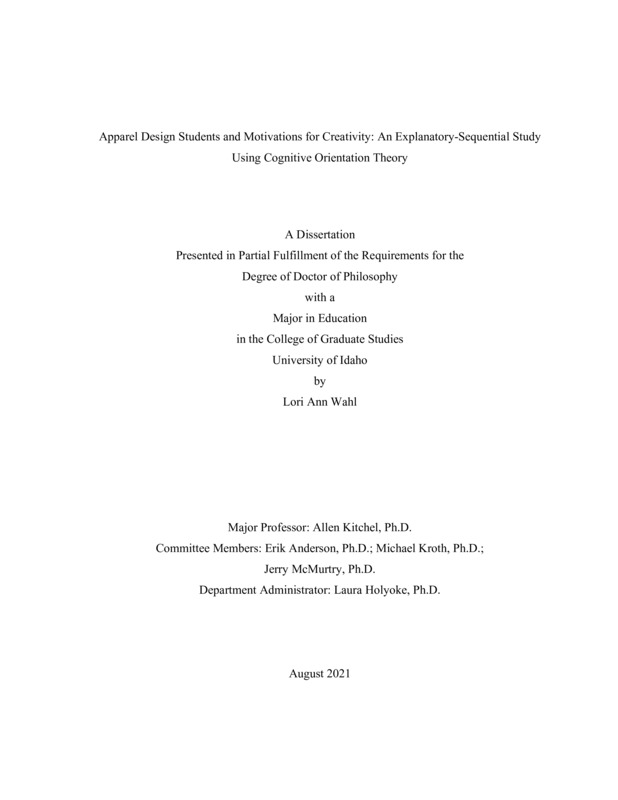Apparel Design Students and Motivations for Creativity: An Explanatory-Sequential Study Using Cognitive Orientation Theory
Wahl, Lori Ann. (2021-08). Apparel Design Students and Motivations for Creativity: An Explanatory-Sequential Study Using Cognitive Orientation Theory. Theses and Dissertations Collection, University of Idaho Library Digital Collections. https://www.lib.uidaho.edu/digital/etd/items/wahl_idaho_0089e_12152.html
- Title:
- Apparel Design Students and Motivations for Creativity: An Explanatory-Sequential Study Using Cognitive Orientation Theory
- Author:
- Wahl, Lori Ann
- Date:
- 2021-08
- Embargo Remove Date:
- 2022-09-01
- Keywords:
- apparel cognitive orientation creativity design motivation students
- Program:
- Curriculum & Instruction
- Subject Category:
- Adult education
- Abstract:
-
The US apparel industry is lacking in skilled workers familiar with technology, and there is a gap between what is taught in post-secondary schools and what is needed on the job. Minimal research is available to guide the apparel design educator and even less regarding apparel technologies. Apparel design students are expected to produce creative outputs during their academic careers and as apparel industry employees. Using Cognitive Orientation theory, this study determined what motivational constructs contributed most to motivations for creativity among apparel design students. Specifically, it investigates apparel design technology students’ perceptions of internal and external motivations for creativity constructs, and the relationship of those constructs to creative outputs. Using an explanatory-sequential study design, the Cognitive Orientation Questionnaire for Creativity (COQ-CR) survey was used to capture a general picture of apparel design student perceptions of motivations for creativity followed by interviews with apparel technology design students. The COQ-CR was also administered to related disciplines of interior design and costume design. A correlational explanatory design correlated apparel design technology student COQ-CR scores with final project creativity scores obtained through the Consensual Assessment Technique (CAT). Descriptive analysis of the COQ-CR was used to determine which constructs contributed most to motivations for creativity for each design discipline group. Using a constructivist paradigm, interviews were analyzed for themes which were then grouped into categories. COQ-CR and CAT scores were correlated using the Spearman Correlation Coefficient. Results indicate that apparel design students are motivated equally by internal and external factors and identified three themes and a belief construct that contributed most to COQ-CR scores. Apparel, interior, and costume design groups scored similarly. Three relatively strong correlations with large effect sizes were found between COQ-CR construct scores and creativity scores. These results suggest that by leveraging innate constructs that are already part of the apparel design student motivational make-up that design project output may be more creative with less coaching from the instructor. Careful selection of project types and goals that relate to these motivational factors that are already valued by the apparel design student could support better project engagement in pursuit of a creative outcome.
- Description:
- doctoral, D.Ed., Curriculum & Instruction -- University of Idaho - College of Graduate Studies, 2021-08
- Major Professor:
- Kitchel, Allen
- Committee:
- McMurtry, Jerry; Anderson, Erik; Kroth, Michael
- Defense Date:
- 2021-08
- Identifier:
- Wahl_idaho_0089E_12152
- Type:
- Text
- Format Original:
- Format:
- application/pdf
- Rights:
- In Copyright - Educational Use Permitted. For more information, please contact University of Idaho Library Special Collections and Archives Department at libspec@uidaho.edu.
- Standardized Rights:
- http://rightsstatements.org/vocab/InC-EDU/1.0/

